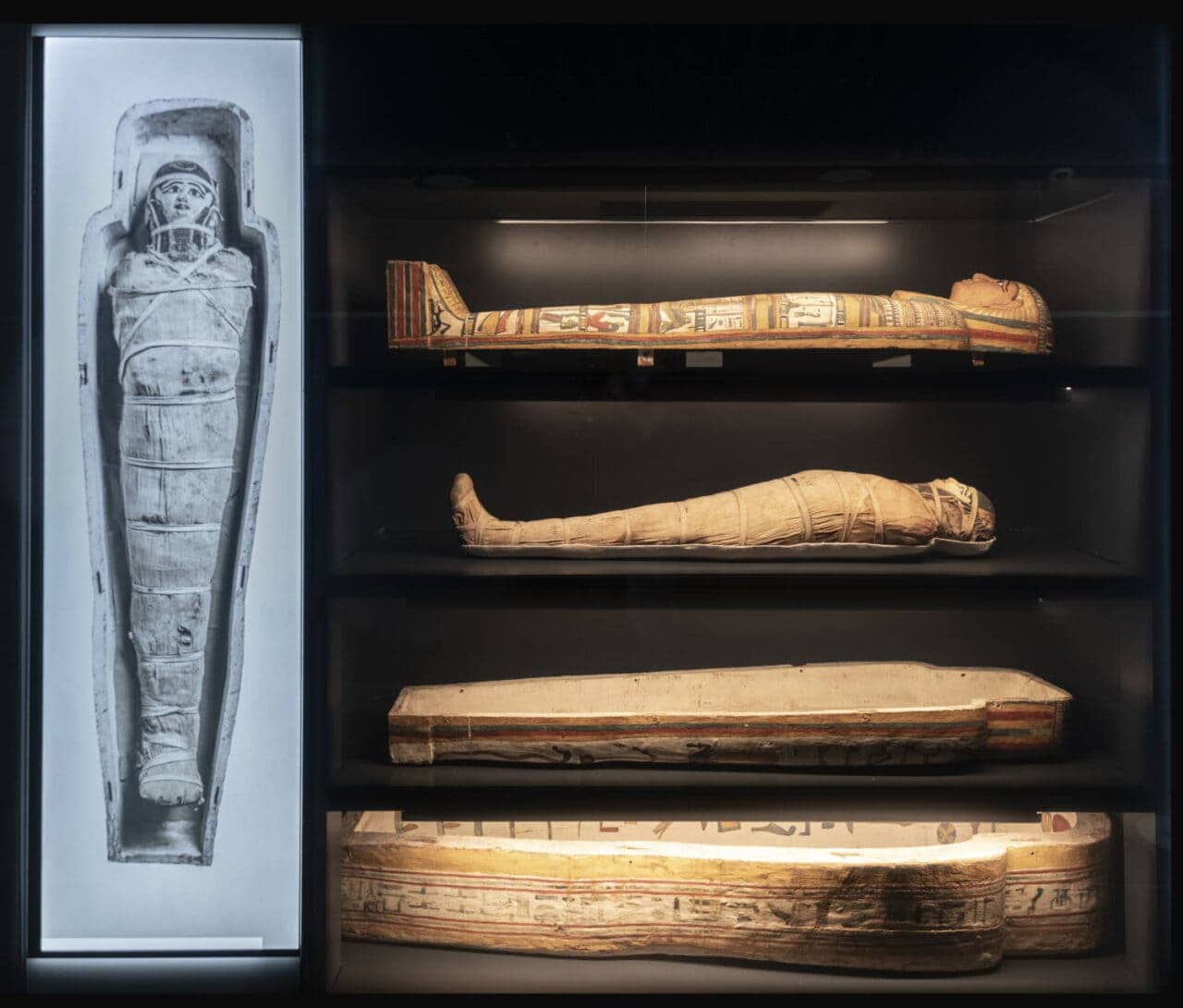
On the first floor of the Egyptian Museum in Turin, a room entitled "In search of life. What do human remains tell us?" was inaugurated at the end of 2021. Inside, a display case with strictly controlled environmental conditions is the new repository for the museum's mummies, but also a showcase for archeological finds that until a few months ago lay hidden from view in storerooms. On display are six individuals of different ages - the first is a foetus probably born prematurely, the last a woman in her fifties, an age of advanced maturity for the time - through which the relationship of Egyptian culture with death at all stages of life is traced. The exhibition of mummies, both human and animal, is certainly nothing new at the Egyptian Museum of Turin, which has been displaying them since the early decades of the 19th century, but certainly new and unprecedented, at least for our country, is the framework in which the room has been conceived and designed: by exhibiting these artefacts, the museum's curators also intend to address the broader issue of the ethical implications of exhibiting corpses and remains of the dead.
Human remains, in fact, have a special status among museum exhibits. By studying them with various techniques, researchers can advance knowledge about human genetics and evolution, diseases and causes of death, demography, culture or the practices of past societies. However, when it comes to remains, and even more so to the whole bodies of the deceased, artefacts are also charged with strong symbolic values, often affecting the sensitivity of visitors, confronting them with their idea of spirituality, and provoking reflections on death. The exhibition of human remains is an issue of which the museum public still has little awareness, but which is very hot among insiders. Thanks to the collaboration of the Egyptian Museum and other institutions, Nicole Crescenzi, a PhD student in cultural heritage at the IMT School, is conducting her research. The title of the project is 'Exhibiting Human Remains: a Cross-Discussion between Ethics, Museology, Archaeology and Law', under the supervision of Maria Luisa Catoni, Professor of Archaeology.
The debate on the display of human remains in museums has roots dating back to the late 19th century. "At that time, especially in countries with a strong colonial imprint, an attempt began to give an obviously false scientific justification to the idea that different human races exist by exhibiting bodies of individuals belonging to indigenous populations," Crescenzi explains.
Especially in the United States, Canada, Australia and New Zealand, this approach has been severely challenged and criticized since the 1970s, and the movement has led to the introduction of laws and regulations prohibiting the exploitation of indigenous bodies and culture for racist purposes. In the United States, for example, the Native American Graves Protection and Repatriation Act, passed in 1990, stipulates that human remains and objects unearthed in the cemeteries of indigenous communities remain their property, and also requires museums to return them if requested by the descendants of the tribes to which they belong.
As part of this debate in the post-colonial context, some museum institutions then began to question the permissibility of displaying human remains of any kind and for any purpose, the public's perception of various types of remains, from bones to a skeleton, parts of organs and tissues, or whole corpses, and in general the purposes for which it may or may not be permissible to display the remains of deceased persons in a museum.
This has resulted in research, documents and guidelines adopted in museums and cultural institutions in various countries, but a comprehensive analysis of all the aspects of the debate - ethical, legal, scientific and cultural - is still lacking. Producing this analysis and making it available is the aim of the study launched at the IMT School. The first phase of the project was the collection of public perceptions through an online questionnaire that produced 1,250 responses. The data will soon be published and will provide researchers with indications of visitors' thoughts and reactions to the sight of the remains, which may eventually be used to design new modalities of exhibition. "What can be said as of now is that most of the people who answered the questionnaire did not even know that such a debate existed," says Crescenzi. "It also becomes clear that public perception is different for different types of rest. It is one thing if it is hair and tissue, bones, or a whole body, as in the case of mummies. However, many have agreed on the need to address this issue, and to establish rules and principles to guide the display of human remains also from an ethical point of view'.
In Italy, we are a little behind other European countries in tackling this debate, and in developing this sensitivity, but there is ferment and interest in the subject. Experiences such as that of the Egyptian Museum, or the conference organised in 2019 in collaboration between Turin and the Archeological Park of Pompeii Pomepii bear witness to this, as the numerous responses from museums to which the questionnaire was sent.
The research of the IMT School will continue with live questionnaires collected in some European museums, and with the comparison of the regulations of different countries.
The indications emerging from the limited existing field research are to "treat these remains with respect", not to exhibit them unless necessary for didactic or educational purposes, and to avoid using them as a morbid attraction for the public. In short, when planning an exhibition, one should be guided by a question: how would I feel if in a thousand years' time my body or parts of my body were displayed in a museum case? Everyone would probably have a different answer to give, but what scholars in this field want to emphazise is that it is important to ask the question.
Chiara Palmerini